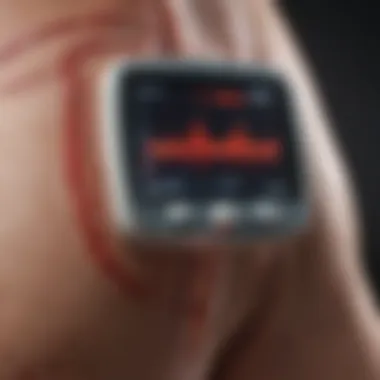Comparative Study of Doppler and Conventional Ultrasound


Intro
In the ever-evolving field of medical imaging, ultrasound technology has carved its niche, finding applications across various medical disciplines. Among the prominent techniques available, Doppler ultrasound and conventional ultrasound have gained significant traction. Each method brings its unique flavor and capabilities to the table. Prepare for a deep dive into these modalities and how they stack up against one another.
Understanding the intricacies of these imaging techniques is crucial for practitioners who aim to leverage technology for patient care. While both Doppler and conventional ultrasound utilize sound waves to produce images, their functionality and applications diverge in meaningful ways. In this exploration, we will dissect the strengths, weaknesses, and ideal use cases of each modality, allowing medical professionals to arm themselves with the knowledge necessary to make informed decisions.
Research Overview
Summary of Key Findings
Research has shown that Doppler ultrasound is exceptionally adept at evaluating blood flow, making it indispensable in cardiovascular diagnostics. On the other hand, conventional ultrasound excels in structural visualization, which is vital for obtaining detailed images of organs and tissues. The two techniques, while related, serve distinct functions;
- Doppler Ultrasound: Primarily focused on assessing blood flow, detecting abnormalities in circulation, and evaluating heart function.
- Conventional Ultrasound: Best suited for imaging solid organs, diagnosing conditions like gallstones, and guiding procedures such as biopsies.
Essentially, the ability of Doppler ultrasound to detect subtle changes in blood velocity can reveal pathology that might remain hidden in standard imaging.
Relevance to Current Scientific Discussions
In recent years, discussions surrounding the efficacy and applications of ultrasound technology have gained momentum in the medical community. This analysis contributes to ongoing conversations about enhancing diagnostic accuracy and patient outcomes. As healthcare providers navigate complex cases, understanding when to employ Doppler versus conventional ultrasound becomes a pressing consideration.
Current research emphasizes the need for an integrated approach—balancing both techniques based on clinical indications—to bolster diagnostic capabilities. Observations gathered from case studies bolster the premise that using the right ultrasound modality can lead to early detection and improved care trajectories.
Methodology
Research Design and Approach
To gather insights, a comprehensive review of recent literature involving both Doppler and conventional ultrasound was conducted. This involved analyzing peer-reviewed articles, clinical studies, and expert guidelines spanning several years.
Data Collection and Analysis Techniques
The data collection for this analysis involved:
- Systematic Literature Review: Collating relevant studies from medical journals, focusing on case studies that highlight the practical application of each ultrasound modality.
- Expert Opinions: Consulting thought leaders in the field of ultrasound imaging to add empirical weight to the findings.
In evaluating the efficacy of each technique, qualitative data was examined to understand the practical nuances and patient outcomes associated with Doppler and conventional ultrasounds.
In summary, this comparative analysis aims not just to inform but to empower medical professionals with a nuanced understanding of these vital imaging techniques.
Understanding Ultrasound Technology
In the realm of medical diagnostics, comprehending ultrasound technology is not merely a task for tech enthusiasts; it holds significant weight for practitioners. Ultrasound technology, a cornerstone in non-invasive imaging, offers detailed insights into the human body. By understanding its principles and applications, healthcare professionals can sharpen their diagnostic acumen, thus enhancing patient care.
It’s essential to wrap one’s head around how ultrasound operates because it influences decisions regarding its usage compared to other imaging modalities. This article takes a closer look at Doppler and conventional ultrasound, both integral to modern diagnostics, but each with unique functionalities that serve different clinical needs.
Basic Principles of Ultrasound
Ultrasound relies on high-frequency sound waves, generally beyond the human hearing range (20 kHz). These sound waves travel through tissues, bouncing back when they encounter different interfaces, which allows for the creation of images. An ultrasound machine converts sound reflections into electrical signals, generating real-time visual representations of what’s happening inside the body.
One of the kernal principles here is the frequency of the sound waves—higher frequencies yield better resolution but have limited penetration depths. This means that when imaging superficial structures, like the thyroid, higher frequencies are advantageous, while deeper structures, like abdominal organs, can often be examined with lower frequencies.
Types of Ultrasound Waves


Understanding the types of ultrasound waves adds another dimension to the conversation.
- Longitudinal waves are typical, moving in the same direction as the wave itself. They’re prevalent in most ultrasonic applications.
- Transverse waves, although less common in standard imaging, drive the mechanics behind some Doppler applications.
This diversity in wave types enriches the versatility of the technology. It allows practitioners to choose the appropriate wave type based on the specific diagnostic requirement, helping to extract maximum information from the imaging process.
Applications in Medicine
The myriad applications of ultrasound technology in medicine speak volumes of its efficiency. Common uses include:
- Obstetrics: Monitoring fetal development and overall health.
- Emergency Medicine: Quickly assessing trauma injuries.
- Cardiology: Evaluating heart function and structure.
Ultrasound technology's non-invasive nature permits repeated examinations without significant risk to patients, making it invaluable in routine clinical practice.
Each application leverages the core principles of ultrasound, specialties such as obstetrics substantially benefiting from ultrasound’s ability to provide real-time imagery while keeping radiation exposure at bay.
In summary, a solid grounding in ultrasound technology lays the foundation for a deeper analysis of both Doppler and conventional techniques in subsequent sections of this article. Understanding the mechanisms and applications sets the stage for more nuanced comparisons that could influence clinical decisions down the line.
An Overview of Doppler Ultrasound
Doppler ultrasound serves as a critical tool within the realm of medical imaging, providing essential insights into the dynamics of blood flow as well as tissue motion. This modality enhances conventional ultrasound techniques by offering unparalleled real-time data on velocities and direction of moving structures, a feature of paramount importance in a variety of medical contexts. The ability to visualize blood flow helps clinicians identify potential abnormalities or issues much more effectively than standard imaging techniques alone.
Principles of Doppler Effect
The Doppler effect relies on the principles of sound wave frequency changes, which occur when the source of the sound and the observer are in motion relative to each other. When a sound wave emitted by a moving object, like blood cells, reaches an observer, its frequency appears to increase or decrease based on whether the object is moving toward or away from the observer. This characteristic is harnessed in Doppler ultrasound to provide vital information regarding the speed and direction of blood flow. The implications of this are huge—using the shift in frequency, healthcare providers can not merely visualize anatomical features but also assess their function dynamically.
Doppler Ultrasound Technology
Doppler ultrasound technology employs high-frequency sound waves to examine and analyze blood flow in real-time. The system integrates advanced signal processing algorithms that interpret the frequency shifts in the received sound waves to create a visual representation of blood flow patterns. This representation can take various forms, such as color Doppler, which uses different colors to indicate the direction of flow and its velocity, or spectral Doppler, which provides a graph showing the speed of blood flow at a specific site. Such versatility enhances diagnostic capabilities, allowing for thorough analyses of vascular health.
Clinical Applications of Doppler Ultrasound
Cardiology
In cardiology, the use of Doppler ultrasound is instrumental in diagnosing and managing heart conditions, including valvular heart disease and congenital heart defects. A key characteristic of Doppler ultrasound in this area is its ability to assess not just the structure but also the hemodynamic function of the heart. This aspect makes it a beneficial choice for diagnosing cardiac abnormalities effectively. The unique feature of cardiology Doppler is its capacity to visualize the flow across heart valves, pointing out discrepancies in expected flow patterns. While this technology provides numerous advantages, including immediate feedback for doctors during procedures, it does embed certain limitations, mainly regarding personnel expertise needed for accurate interpretation.
Obstetrics
Doppler ultrasound plays a vital role in obstetrics, particularly concerning fetal well-being. It is particularly good at detecting fetal heart rate and assessing placental blood flow. A hallmark of obstetrics Doppler is its non-invasive nature, enabling thorough monitoring without risk to the mother or the unborn child—a crucial consideration during pregnancy. A significant benefit of this application is that it allows for early identification of growth restrictions or distress, giving clinicians a head start in managing care. However, one drawback might be the potential for misinterpretation due to varying maternal body types, which can obscure the data.
Vascular Imaging
Vascular imaging employs Doppler technology to evaluate blood flow in arteries and veins, identifying conditions like deep vein thrombosis or arterial stenosis. A salient characteristic of vascular imaging is its real-time feedback capabilities, particularly useful during interventions like angioplasty. The primary benefit is its effectiveness in validating the success of various vascular procedures directly. However, an ongoing challenge in this field lies in the variability of results based on the angle of insonation, which might require corroborative tests to confirm findings.
"Doppler ultrasound has transformed our capability to assess and manage various medical conditions, putting real-time diagnostics directly into the hands of clinicians."
Conventional Ultrasound Techniques
Conventional ultrasound techniques form a foundational pillar in the field of medical imaging. Their importance cannot be overstated, primarily due to their non-invasive nature and the ability to provide real-time visualizations of soft tissues and organs. As healthcare professionals navigate clinical decision-making, the role of these techniques becomes paramount, especially when considering factors like patient safety, diagnostic efficiency, and the advancement of treatment protocols.
Specific Elements and Considerations of Conventional Ultrasound
One significant aspect of conventional ultrasound is its reliance on sound waves, which are safely emitted into the body and then reflected back. This method offers a clear image representation of anatomical structures. Unlike other imaging modalities that rely on ionizing radiation, conventional ultrasound provides a safer alternative, especially for vulnerable populations such as pregnant women and children. Moreover, the technique is relatively cost-effective, which makes it widely accessible in various healthcare settings.


How Conventional Ultrasound Works
At its essence, conventional ultrasound works on the principle of sound wave transmission. The ultrasound machine utilizes a transducer that emits high-frequency sound waves. When these waves encounter different tissues in the body, they are reflected back to the transducer. The machine then converts these returning sound waves into visual images. This process is known as echolocation, and it allows clinicians to assess the structure and function of internal organs without any invasive procedures.
The success of this technique hinges on the skill of the operator, as capturing high-quality images requires a careful understanding of ultrasound physics and anatomy.
Routine Clinical Applications
Abdominal Imaging
Abdominal imaging via conventional ultrasound is a cornerstone in diagnosing conditions affecting organs such as the liver, kidneys, and pancreas. Its key characteristic is the ability to visualize soft tissue structures with remarkable clarity, which is beneficial when assessing for abnormalities such as cysts or tumors.
What sets abdominal imaging apart is its immediacy and the non-invasive nature, allowing for a rapid assessment in acute settings. One unique feature is the use of color Doppler ultrasound to evaluate blood flow in abdominal organs, offering a hybrid perspective that can enhance diagnostic capabilities. However, it's important to note that while conventional ultrasound is effective, limitations exist, particularly in imaging deeper structures where attenuation of sound waves can obscure the clarity of the images.
Pelvic Imaging
Pelvic imaging serves a critical role in examining structures such as the bladder, ovaries, and uterus. The ability to visualize these organs clearly allows for diagnoses concerning reproductive health, such as ovarian cysts or uterine fibroids. This technique is popular for several reasons, not least of which is the speed of acquiring images and the high patient compliance due to its non-invasive setup.
A notable feature of pelvic imaging is the transvaginal or transrectal approach, providing closer proximity to the structures being examined. However, limited visualization of surrounding organs can be a drawback, especially in distinguishing between overlapping structures.
Thyroid Studies
Thyroid studies via conventional ultrasound are vital in evaluating the structure and function of the thyroid gland. Its primary characteristic is the capability to detect nodules and assess their characteristics, thereby guiding clinical management. This makes thyroid studies a common practice in endocrinology.
One unique feature is the use of fine needle aspiration biopsy, which can be performed under ultrasound guidance for solid nodules, enhancing diagnostic yield. Despite its advantages, the technique does have limitations, particularly in differentiating between benign and malignant nodules without further histological examination.
Limitations of Conventional Ultrasound
While conventional ultrasound is a powerful tool, it does have its share of limitations. One major drawback is its operator dependence; the skill of the technician significantly impacts the quality of images obtained. Additionally, anatomical challenges such as obesity can hinder sound wave penetration, making it difficult to visualize certain structures.
Moreover, conventional ultrasound has inherent limitations in the depth of tissue it can assess effectively. In some cases, additional imaging techniques might be needed to complement conventional ultrasound to attain a more accurate diagnosis. As such, while it remains a staple in medical imaging, understanding its limitations is essential for optimal patient care and treatment planning.
Comparative Analysis of Doppler and Conventional Ultrasound
Understanding the distinctions between Doppler and conventional ultrasound is essential not only for practitioners in the field but also for the future of medical diagnostics. Each technology has its niche, and recognizing their strengths and weaknesses empowers healthcare professionals to make informed choices tailored to patient needs. This analysis delves into specific elements that define the effectiveness of each approach, providing valuable insights into the therapeutic landscape.
Technological Differences
Doppler ultrasound sets itself apart primarily through its ability to measure blood flow and motion within the body. In contrast, conventional ultrasound emphasizes structural imaging, delivering clear pictures of organs and tissues. Utilizing high-frequency sound waves, both modalities generate images; however, the technology behind them diverges significantly.
- Wave Propagation: Conventional ultrasound relies on reflected sound waves to portray static images, whereas Doppler ultrasound tracks frequency shifts in waves caused by moving objects such as blood cells.
- Equipment Complexity: The equipment used in Doppler techniques often includes additional components, such as spectral analysis software, which enriches the data obtained.
- Image Output: Conventional ultrasound graphs are more straightforward, while Doppler creates a dynamic representation, often layering color to indicate flow direction and velocity.
In practical use, understanding these technological differences allows healthcare providers to select the appropriate modality based on the diagnostic question at hand. Doppler excels in vascular assessments, while traditional ultrasound is preferred for general imaging, such as obstetrics.
Diagnostic Accuracy and Interpretation
When it comes to diagnostic accuracy, the two methods shine in different arenas. Doppler techniques are pivotal for real-time assessment of blood flow, often revealing conditions that traditional ultrasound might miss. Its ability to detect turbulence and occlusions lends it precision in scenarios like cardiology and vascular health. Moreover, Doppler ultrasound's nuanced interpretations give a clinicians insights into dynamic physiological processes that static images cannot provide.
On the other hand, conventional ultrasound remains highly effective for visualizing anatomical structures and is often more user-friendly when it comes to interpretation. This straightforward nature makes it widely accessible across various healthcare settings. However, missed pathologies like early signs of ischemia or conditions affecting blood flow may occur if practitioners solely rely on conventional methods. Proper training is essential to ensure accurate interpretation, regardless of the technique used.
Cost-Effectiveness and Accessibility


Evaluating cost-effectiveness reveals a considerable disparity between these two methodologies. Conventional ultrasound tends to be the more economical option, primarily due to the lower costs associated with the equipment and the training required for personnel. This affordability often encourages its use in primary care, enhancing access for many patients who might otherwise struggle to receive timely diagnostic evaluations.
Doppler ultrasound, while more diagnostically nuanced, often comes with higher expenses. The equipment can be significant in price, and the requirement for more specialized training for technicians can further drive up costs. Despite these factors, the clinical information derived from Doppler can justify the investment in specific cases, particularly in acute settings.
"Opting for the right technology is less about preference and more about necessity—understanding the clinical question is key to making an informed choice."
Implications for Clinical Practice
Understanding how both Doppler and conventional ultrasound techniques fit into clinical settings is essential for delivering effective patient care. Each method brings its own set of strengths and considerations, influencing not just the diagnostic outcome, but also the management strategies adopted by healthcare professionals. With advances in medical imaging technologies, it’s vital to weigh the pros and cons of each modality in real-world applications.
Choosing the Right Modality
Selecting the appropriate imaging technique often hinges on specific clinical needs. Doppler ultrasound has carved a niche for itself in areas requiring dynamic assessment of blood flow, making it a go-to choice for cardiology and vascular studies. In contrast, conventional ultrasound shines in static imaging, particularly in evaluating soft tissues and organs.
- Clinical Scenario: In a situation where vascular obstruction is suspected, Doppler ultrasound provides vital information regarding blood flow dynamics, helping to guide urgent interventions.
- Routine Check: For routine pregnancy scans, conventional ultrasound offers clear imaging of fetal development without the complexities of Doppler measurements.
- Cost Consideration: Choosing the right modality also takes into account equipment costs and operational expenses, as some healthcare facilities may find conventional ultrasound more accessible due to its wider availability and lower operating costs.
Overall, clinicians must analyze specific patient cases, weighing efficiency against cost and availability to determine the best imaging option.
Training and Expertise
In the realm of medical imaging, the competency of the personnel administering these techniques cannot be overstated. Training programs play a crucial role in ensuring practitioners are well-versed in utilizing these modalities effectively.
To effectively perform and interpret Doppler studies, operators need an in-depth understanding of hemodynamics and the Doppler effect. On the other hand, conventional ultrasound training focuses on mastering anatomy and ultrasound physics. Each has its own learning curves and requirements:
- Hands-on Training: Serous practical experience is needed for both modalities. Students should not just learn the theory but practice in real-world settings.
- Certifications: Accreditation programs for both Doppler and conventional ultrasound are available, ensuring that practitioners have met specific knowledge and competency standards.
- Continuous Education: With rapid advances in technology, ongoing education becomes necessary for professionals to stay updated with the latest techniques and best practices.
"Investing in consistent training ensures that diagnostic outcomes improve and patient safety remains a priority."
Future Directions in Ultrasound Technology
Looking towards the future, advances in ultrasound technologies indicate a promising landscape for both Doppler and conventional techniques. The integration of artificial intelligence (AI) is anticipated to revolutionize interpretation and operational efficiency.
- Enhanced Imaging: Innovations such as 3D and 4D ultrasound are already making waves, offering detailed visualization that traditional methods struggle to match.
- Telemedicine: Remote ultrasound capabilities are becoming increasingly vital, especially in underserved areas where access to specialists is limited. These advancements allow for the diagnosis of conditions from a distance, enhancing patient outcomes.
- Point-of-Care Testing: Portable ultrasound machines, including handheld devices, are gaining traction in emergency and primary care settings. These gadgets allow for rapid assessments right at the patient's bedside, ensuring timely interventions.
As these technologies evolve, practitioners will need to adapt, embracing innovations that can lead to better diagnostic precision and improved patient care.
Closure
The conclusion section is quintessential in distilling the essence of our exploration into Doppler ultrasound and conventional ultrasound techniques. This part emphasizes the critical elements that have been discussed, synthesizing key points and providing a roadmap for future considerations.
The benefits of a well-rounded understanding of these modalities cannot be overstated. In an era where medical technology evolves at breakneck speed, recognizing the roles these ultrasound techniques play in diagnostics is paramount for effective patient care. Choosing the appropriate modality based on specific patient needs can drastically enhance diagnostic accuracy.
Moreover, we have touched upon the implications for clinical practice, especially in relation to training and expertise. A thorough grasp of the nuances between Doppler and conventional ultrasound ensures that healthcare professionals are better prepared to use these technologies adeptly, enhancing clinical outcomes.
Summarizing Key Insights
To wrap up the discussion, a few key insights emerge:
- Technological Distinctions: Doppler ultrasound provides real-time insights into blood flow and velocity, setting it apart from conventional methods that primarily capture structural information.
- Clinical Relevance: Each modality has its unique strengths; Doppler excels in vascular studies while conventional ultrasound is often relied upon for structural evaluations in various anatomical regions.
- Cost and Accessibility: While Doppler may offer advanced diagnostic capabilities, it can come at a higher cost than its conventional counterpart. This factor should not be overlooked when selecting the appropriate diagnostic approach.
These insights sketch a clear image of how both ultrasound techniques hold unique places in the medical field. They bring to the forefront the importance of informed decision-making based on solid, clinical evidence.
Closing Thoughts on Advances in Ultrasound
Looking toward the horizon, the advancements in ultrasound technology are promising. With the continuous evolution of imaging techniques and tools, we can anticipate more integrated and sophisticated systems. For instance, the rise of portable ultrasound devices has the potential to provide improved accessibility to echocardiographic and vascular assessments in diverse clinical settings.
We must also consider how emerging artificial intelligence applications are streamlining workflows, making it easier for practitioners to interpret ultrasound data. In this context, understanding both Doppler and conventional techniques lays the groundwork for embracing innovations that can further the field of medical diagnostics.
Reflecting on the journey through ultrasound technologies, the emphasis remains clear: knowledge is power. By equipping ourselves with the nuances of these techniques, healthcare professionals can drive forward meaningful advancements in patient care.



